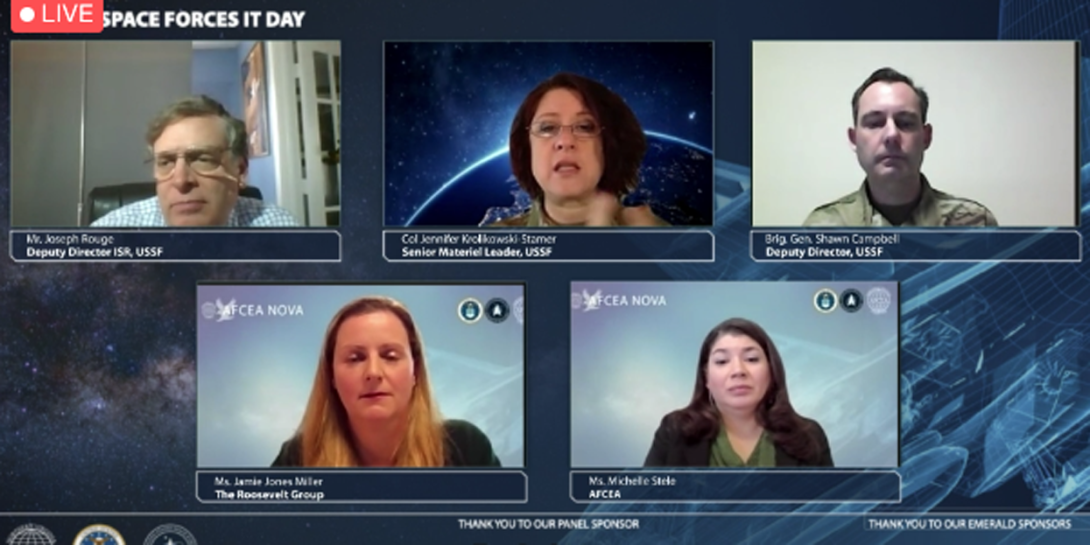Space Force on Its Way to 16,000 Personnel
The U.S. Space Force plans to have a mix of about half military and half civilian workers, reaching roughly 16,000 personnel. As of the end of last week, 2,206 enlisted and officer personnel had transferred into the new service, reported Brig. Gen. Shawn Campbell, USAF, deputy director of Personnel, U.S. Space Force. Almost 60 more field-grade officers will move into the Space Force shortly, after Congress approves these non-space operators, who will work in intelligence, cyber, engineering or acquisition roles.
“We are growing a little bit at a time,” the general said. “And we are on track to be right around 6,400 military personnel in the space force at the end fiscal year 2021, which will include 256 new officers and about 312 enlisted personnel." The general was also pleased to see that the first seven space operators had graduated this week from basic enlisted military training at Lackland Air Force Base, Texas, and are going directly into the Space Force. “That is very exciting for us,” he noted.
As the new service grows, it is emphasizing its digital fluency and establishing its own organizational identity, in a ‘team of teams’ environment, Gen. Campbell stated.
“We talk very deliberately about being the first fully digitally enabled force,” he said. “We hear [chief of Space Operations] Gen. [Jay] Raymond often use the phrase ‘clean sheet.’ He didn't want us to simply become ‘Air Force light’ or ‘Air Force like’ as we stood up. The service really wants to have our own culture, and part of the way that you do that is in how you develop a human capital strategy.”
Gen. Campbell noted that the ‘team of teams’ approach will begin with how the service performs personnel assessments. They will look at how an employee is contributing to the group effort, instead of just focusing on individual accomplishments.
“We want to move beyond the idea that there is an individual that fills a role inside the Space Force,” he said. “We will look at your commitments and your contributions to the team as part of that assessment. We are starting with a different framework where we want everyone in the Space Force to have a growth mindset and an outward mindset.”
The general also is promoting the idea of service members’ access to top leadership through open dialogue. “It could be similar to what Jeff Bezos does at Amazon,” Gen. Campbell noted. “Where the entire force has an opportunity to interact with Gen. Raymond and not to just hear where he is coming from or what his strategy is or his guidance, but actually engaging directly [with him] a couple of times a month in conversation.”
Col. Jennifer Krolikowski, USSF, senior materiel leader, Space Force, who is helping the development of the service’s Space Command and Control (C2) program at the Kobayashi Maru software factory at the Space and Missile Systems Center (SMC), agrees with the general that the Space Force needs a digital focus.
“We definitely take that digital force mindset,” she stated. “A lot of the cultural aspects that he was talking about have been embodied within Kobayashi Maru and how we operate.”
In fact, the colonel said, the shift to Agile software development brought the software factory more successful outcomes, as far as its C2 products. “We flipped to more Agile practices and then we were able to see immense speed of success and delivery in our code,” Col. Krolikowski explained. “In just the two years since we have stood up, we've delivered six applications to the operational floor that have been completely accepted and are being used in operations today. That is tremendous when you consider the previous work that we had done was under development for about five years, and we spent an inordinate amount of money and never actually delivered anything.”
In providing the operational layer for C2 for warfighters in the space domain, the software factory’s efforts also will plug in directly to support the space layer of U.S. military’s multidomain operations and joint all-domain command and control initiatives.
“You can imagine that there is a lot of software involved and how you build the ecosystem and how you work to get all of our partners together to be able to contribute to this particular mission,” the colonel added.
The general and the colonel spoke during the AFCEA NOVA Chapter’s Air Force and Space Force Information Technology Day on December 15, along with other panelists: Jamie Jones Miller, senior advisor at The Roosevelt Group; Michelle Steele, senior manager, Deloitte; and moderator Joseph Rouge, deputy director of Intelligence, Surveillance and Reconnaissance, Space Force.





Comments